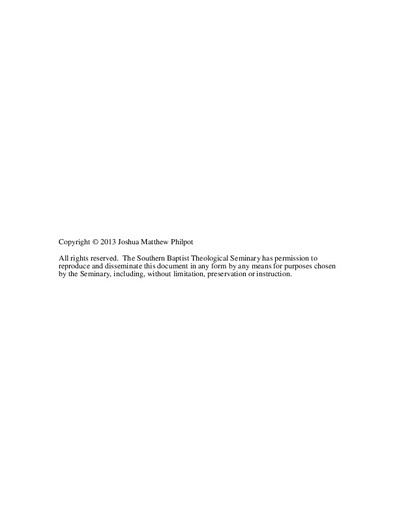| dc.description.abstract | This dissertation constitutes a fresh interpretation of Exodus 34:29-35 and analyzes how the passage is used in both the Old and New Testaments. Chapter 1 is a historical overview of how this passage has been interpreted through the centuries. Chapter 2 provides an exegetical discussion of Exodus 32-34, which makes up the context of the passage in question. Chapter 3 argues that the primarily exegetical problem within this passage, the identification of the meaning of the verbal form of "qrn," is resolved by the recognition that it means "to shine" or "emanate light/rays" as opposed to "had horns" or other interpretations. The function of the entire phrase--"the skin of his face shone"--is fourfold: as a reminder or extension of Yhwh's presence at Sinai, to distinguish Moses in terms of status, to communicate Yhwh's "goodness," and to transition from the rebellion narrative in chapters 32-34 to the building of the tabernacle in 35-40. Knowing the function of the phrase sheds light on the concomitant matter of Moses' veil ("masweh"), which is more akin to a scarf than to a mask, and which functions simply to hide Moses' face when he is uninvolved with his role as mediator because his face was frightening and disturbing to the Israelites. The exegetical study in chapter 3 culminates in an explanation of the theology of Exodus 34:29-35, focusing on God's presence, glory, grace/compassion, and life/light. This thesis is developed in chapter 4, which shows that how certain OT passages highlight the image of a shining face as a theological metaphor for grace and compassion. Many later biblical texts (e.g., Num 6:24-27, portions of the Psalter and the book of Daniel) also echo this language in prayers and songs. In addition, idiomatic expressions about the "face" or the brightness of the face are found in some extrabiblical sources and ANE inscriptions, which confirm and validate the interpretation in chapter 3. Three further texts are examined with relation to the role of Sinai theophanies (1 Kgs 19), the "veiling" of God's presence in the future (Hab 3:1-4), and images of God's eschatological glory (Isa 60:1-5, 19-20). Chapter 5 applies the OT study to the NT, where special attention is given to three passages: the narrative of the transfiguration of Jesus in Matthew 17:1-8, Paul's statements in 2 Corinthians 3:7-18 about the old and new covenants, and the prologue to John's Gospel in John 1:1-18. Chapter 6 summarizes the study and concludes the work. | en_US |

